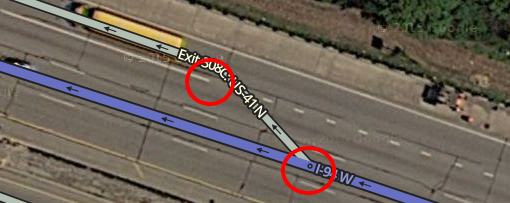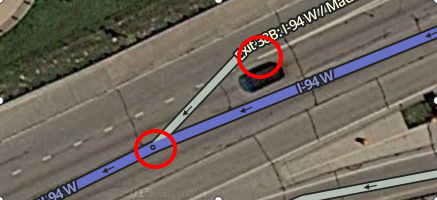Functional Classifications
Wisconsin follows the Functional Classification (FC) system for the USA.
To help update the current Wisconsin roadways to the new functional classifications, go to the Wisconsin Functional Classification Inventory.
Links to the FC maps for the state of Wisconsin can be found on the Wisconsin/Resources page.
Minimum Road Lock Standard
| Minimum Road Lock Standard | ||
|---|---|---|
| Segment Type | Direction | Level |
| Freeway | 5 | |
| Ramp | HCS* | |
| Major Highway | 3 | |
| Minor Highway | 3 | |
| Primary Street | One-way | 3 |
| Two-way | 2 | |
| Street Private Road |
One-way | 2 |
| Two-way | 1 | |
| |-|-|-|-|-|-|-|-|-| Railroad |-|-|-|-|-|-|-|-|-| | 2 | |
| • • • • Ferry • • • • | 2 | |
| ⁃ ⁃ ⁃ ⁃ ⁃ Runway ⁃ ⁃ ⁃ ⁃ ⁃ | 5 | |
| Other Named Types | 1 | |
| Segment Group | Level | |
| Construction Areas (changes without aerial images) |
3 | |
Terms
- HCS - Highest Connecting Segment
Additional Info
Expectations
We understand that higher locks mean there is less available to lower rank and beginning editors. We would like to emphasize that Waze Map Editing is a community activity and, within the US, it is not possible to increase to rank 3 or above without community involvement. It is the responsibility of all members of the editing community to actively reach out, recruit, and mentor new editors.
It is OK to temporarily lock segments below standards for more junior editors. Area Managers are encouraged to monitor their areas for non-standard locks and follow up with other editors on any discrepancies. As a courtesy, any down-locks made outside your area should be brought to the attention of the local area manager.
One-Way Streets
The +1 locks on one-way segments originated as guidance from GLR RC GizmoGuy411 based on trends found while performing Area Manager Reviews: He would encourage editors to +1-lock one-way street/PS in order to explicitly signal, "Yes, the legwork has been done in order to confirm this segment really is one-way, and it's not a soft-directional issue."
Name Normalization
Wisconsin will use the following standards for road naming:
Freeways - I-###
US Highways - US-###
State Highways - WIS-###
County Highways - CH-XXX
Forest Roads - FR-###
| There are no Township (Town) Roads in the state. All Town Roads are named, and those names will be used. The only exceptions would be if the road signage states differently. |
Bridge and Overpass Segmentation Elevation (BOSE)
Please note that there are regional and national discussions ongoing for establishing standards beyond state level. If those changes come in opposition to what we are doing here, then we will be changing to follow suit.
Wisconsin has decided on a state standard for the segmentation of bridges and overpasses.
The National Wiki contains the standard information regarding proper elevation of segments. What we are doing in Wisconsin is expanding on those standards to create a more accurate representation of the segments.
Basic elevation is determined using the following rules:
- All roads start at Ground elevation
- If a segment is above another segment, it should be set to +1 relative to the lower segment's elevation (to account for multiple segments overlapping)
- If a segment is a tunnel (not just an underpass), it should be set at -1, and Tunnel should be checked.
Bridges
Definition:
- If a segment travels over a river or body of water, it is considered a bridge
- If a segment travels over another segment, it is considered it a bridge (aka: overpass).
- If a segment is artificially elevated to pass over ground level objects and natural features, it is considered a bridge.
Junctioning:
Place a junction at the start/end of the bridge where the land falls away.
- If there is already a junction within 500 feet of the bridge, do not add a new junction.
- Do not junction a bridge if it is less than 75 feet in length. If you believe you need to do so, contact an SM or LAM for approval.
Ramps
Ramps should always be set to Ground. The only time a ramp segment is set above or below ground is when it travels above or below another segment as a bridge or a tunnel. This is most often the case in large interchanges, like the Marquette interchange in Milwaukee. When a ramp traverses over or under another segment, you should follow the elevation guidelines listed above.
Do not segment a ramp like you would for a bridge, unless it takes on several different elevations.
Because of the complexity of interchanges, please contact your State Manager before making adjustments.
Special Note
This process was derived from the Seagull Effect created by the Australians. The process has been unofficially called ‘seagulling’. Please note that this word is a misuse of the Seagull Effect. Using it may have unintended connotations.
Additional notes for this state
Dirt Roads
All drivable unpaved (Dirt/Gravel) roads should be classified as per Functional Classification. The Unpaved checkbox should then be selected, as this will allow the "Avoid Dirt Roads" feature in Waze to behave properly.
Trails and non-standard roads that may require special equipment to drive on, should either not be mapped, or be classified as an "Off Road / Not Maintained" road with the Unpaved checkbox ticked.
Toll Roads
There are currently no toll roads in Wisconsin. No segments within the state of Wisconsin should be marked as 'Toll Road'.
Pedestrian Boardwalk, Walking Trail, Stairway
These should not be mapped without approval from a State Manager for Wisconsin or the Regional Coordinator. These segment types can cause routing issues even when not connected to a drivable segment.
Solid White Lines
It is not illegal to cross a solid white line in the state of Wisconsin, unless posted Wisconsin Statute 346.13(3).

Some examples are: road edge lines, lane divider lines, or on/off ramp lane lines. Even though it is not illegal, it is a safe driving practice to not cross these lines. When mapping on/off ramps, please follow national guidelines in the Junction Style Guide/Interchanges section.


There may be times when this is impractical, in such instances, contact a State Manager for further guidance.
Roundabouts at Freeway Interchanges
When there are roundabouts at freeway interchanges, leave the connecting overpass/underpass roads un-named. Waze will read forward to the next roundabout and provide proper TTS and visual prompts for the user to aid in proper lane selection at multi-lane roundabouts.
Here is an example of when not to name the segment(s): Do Not Name
U-Turns
U-turns in Wisconsin are permitted when:[1]
- The u-turn can be made in safety and without interfering with other traffic.
- Not upon any curve, or upon the approach to or near the crest of a grade, where the vehicle cannot be seen by the driver of any other vehicle approaching from either direction within five hundred (500) feet.
- Not explicitly prohibited by signage or local municipal law.
- You are not required to back up during the course of the u-turn in order to complete it.
For Waze routing, u-turns should only be enabled where they provide the potential for improved routing, which includes recovering from missed turns. A common example is a median-divided primary street that has homes/businesses with their driveways/entrances directly on it, where reaching them would otherwise require lengthy, multi-turn deviations through side roads in order to end up on the correct side of the median.
U-Turns are not allowed on any Freeway or Expressway.
Construction Zones
If a construction zone is expected to last one week or longer, the following options are allowed to be made to the area:
- Change speed limit to lower posted limit
- Add crossovers for traffic changes and make one-way Freeway segments two-way.
If any or all of these changes are made, add the construction zone to the following spreadsheet for easy reference and followup by other editors. WI Construction Zones